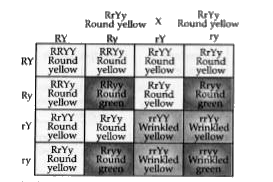The plants bearing round yellow coloured (RrYy) seeds are self pollinated. Represent the result obtained in the F2 generation of dihybrid cross with the help of a checker board. Mention the varieties of plants obtained in F2 generation.
OR
What is evolution ? Explain the three evidences for evolution.
Text Solution
 OR
OR
Evolution is the process of change from simple life forms to complex Life forms by gradual change. It is generating diversity and shaping the diversity.
Three factors / evidences and their roles.
(i) Analogous organs : The analogous organs have different basic design and structure but perform similar functions. e.g., The wings of insects and the wings of birds.
(ii) Homologous organs : The homologous organs have similar basic design and structure but perform different functions. e.g., Forelimbs of a frog, lizard, bird and man
(iii) Fossils: Allow us to make estimates of how far back evolutionary relationships go. Fossils when chronologically arranged help in tracing the evolutionary history of an organism. e.g., Archaeopteryx looks like a bird but it bears many characters of reptiles. This proves that birds have evolved from reptiles.
|
Topper's Solved these Questions
- SSLC KARNATAKA JUNE 2020 CLASS -X BOOK - OSWAAL PUBLICATIONCHAPTER - SSLC KARNATAKA JUNE 2020 CLASS -X EXERCISE - VI. ANSWER THE FOLLOWING QUESTION
1 Videos
- SSLC KARNATAKA JUNE 2020 CLASS -X BOOK - OSWAAL PUBLICATIONCHAPTER - SSLC KARNATAKA JUNE 2020 CLASS -X EXERCISE - IV. ANSWER THE FOLLOWING QUESTIONS.
9 Videos
- SOLVED PAPER SSLC KARNATAKA APRIL 2019 BOOK - OSWAAL PUBLICATIONCHAPTER - SOLVED PAPER SSLC KARNATAKA APRIL 2019 EXERCISE - QUESTIONS
49 Videos
Similar Questions
Knowledge Check
How many plants are dihybrid in F2 generation of dihybrid cross :-
AOneBTowCFourDSixteenWhat is the frequency of pure round seeded pea plants in F2 generation of a dihybrid cross -
A4/16B6/16C1/16D2/16What are the expected phenotypes in F2 generation of cross RRYY × rryy
AOnly wrinkled seeds with green cotylendonsBOnly wrinkled seeds with yellow cotyldonsCOnly round seeds with green cotyledonsDFour, round seeds with yellow cotyledons, round seeds with green cotyledons, wrinkled seeds with yellow cotyledons and wrinkled seeds with green cotyledons
When Mendel self pollinated the F1 plants of genotype RrYy, in the F2 generation, the yellow and green colour segregated in the ratio
View SolutionHybrid Pea plant with yellow round seeds (YyRr) is self pollinated. Phenotypic ratio of next generation would be
View SolutionWhen Mendel self pollinated the F1 plants of genotype RrYy, in the F2 generation, the yellow and green colour segregated in the ratio
View SolutionIn a dihybrid cross between RRYY and rryy parents, the number of RrYy genotypes in F2 generation will be:
View SolutionHybrid Pea plant with yellow round seeds (YyRr) is self pollinated. Phenotypic ratio of next generation would be
View Solution
